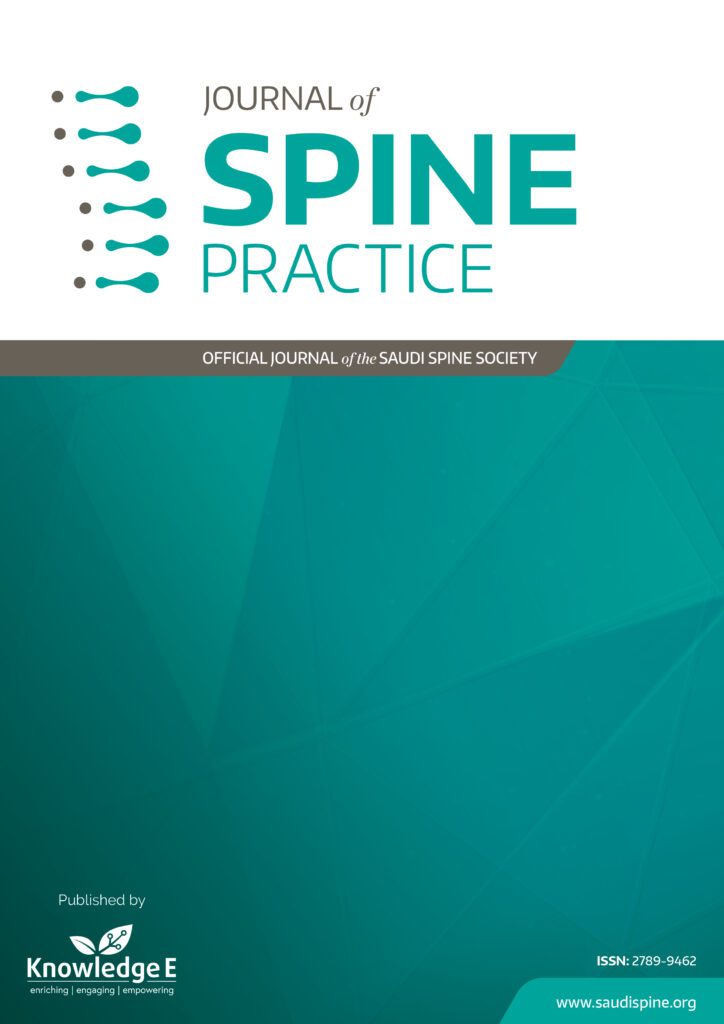
Journal of Spine Practice
ISSN: 2789-9462
Leading research in all spine subspecialties focusing on orthopaedic spine, neurosurgery, radiology, and pain management.
Scoliosis Secondary to Lumbar Spine Herniated Nucleus Pulposus in Adolescents: A Case Report
Published date: Nov 07 2021
Journal Title: Journal of Spine Practice
Issue title: Journal of Spine Practice (JSP): Volume 1, Issue 1
Pages: 23 - 24
Authors:
Abstract:
Introduction: Herniated nucleus pulposus (HNP) is infrequent among children and adolescents. The first case of surgical intervention for disc herniation was reported in a 12-year-old child. Since then, very few cases or series of cases have been published. The reactive scoliosis is frequently associated with lumbar HNPs, a compensatory effort to relieve nerve compression. Moreover, reactive scoliosis secondary to lumbar HNP is typically associated with children and usually resolves with effective management of lumbar HNP. Although the surgical intervention is frequently employed among adults, only 0.5% of discectomies are carried out in children <16 years old. The current case report is of a 15-year-old girl, with no history of spinal ailment, who presented with a large disc herniation at L4–L5 region, associated with a reactive secondary scoliosis, which was resolved following a successful surgical intervention.
Case Report: A 15-year-old female with known case of scoliosis and a history of lower back pain for nine months following a fall while playing football presented at outpatient clinic. She sought medical opinion after two months of persistent pain with radiculopathy to the right side toward big toe. Similarly, there was normal plantar reflex and no clonus or Hoffman sign. There was positive straight leg raise test as well as positive contralateral straight leg raise test. Scoliosis is idiopathic in majority of young patients. However, it might also arise as a part or complication of a triggering health state. Although scoliosis has been frequently associated with lumbar HNP among adolescents, most patients with lumbar disc ailment in this age group might be underdiagnosed initially. Similarly, in our case study the patient was not diagnosed when medical opinion was sought after two months of persistent pain with radiculopathy to the right side toward big toe. The clinical characteristics of pediatric lumbar HNP are usually comparable to those seen in adults; however, one distinguishing feature is that up to 90% have a positive straight-leg raising test. The most common symptom is lumbar pain; limitation of lumbar motility and lassegue are the most common signs. The etiology, pathophysiology, and patterns of the scoliotic posture in cases secondary to HNP remain debated. It is highly recommended to do CT scan in cases of adolescent lumbar HNP to rule out apophyseal ring fracture; accurate diagnosis helps surgeon in planning the appropriate surgical intervention needed. Scoliosis secondary to lumbar disc herniation is observed occasionally, therefore, its clinical significance and pathophysiology are not well-established. However, it is well-recognized that children’s spines have superior adaptive capacity, which shields nervous tissue. An example of this could be scoliosis in patients with root compression, when they bend to the side contrary to the compression, causing an enlargement of the affected foramen and root release. It has been reported that 80% of the patients with disc herniation and scoliosis had the convexity on the side of the root compression. The MRI findings revealed that the scoliosis widened the foramen. Similarly, in our case report the X-ray depicted scoliotic deformity with convexity toward the right side. MRI is the best imaging technique to indicate disc herniation and eliminate other likelihoods in both children and adolescents. Surgical interventions, such as micro-endoscopy discectomy and percutaneous endoscopic lumbar discectomy, could achieve considerable pain relief and function improvement. Our case finding revealed that microscopic discectomy relieved the pain and improved the scoliosis.
Conclusion: Lumbar disc herniation is a rare entity among both children and adolescent and may also result in scoliosis and lumbar pain with or without sciatica. Therefore, lumbar disc herniation in association with scoliosis need vigilant evaluation of signs and symptoms in addition to appropriate diagnostic imaging. Imaging has a vital role in the diagnosis of underlying disease state and helps in clinical management along with surgical planning. The appropriate treatment is discectomy.
References: